Overview of the water pump "Trickle": device, connection and operation rules
If you take at random a dozen summer cottages, at least one of them has a water pump, a Trickle. This relatively small device has been successfully used for decades throughout the territory of Russia, the near, and in some places far abroad. Handled correctly, this tireless worker will benefit in the home and garden for many years to come.
The Trickle pump is one of the most popular vibration-type pumps. The central part of the structure of this unit is the membrane. When the pump is turned on, it is attracted and repulsed by the electromagnetic coil built into the pump. Oscillatory movements of the membrane create a pressure difference in the pump casing, which allows water to be moved to a sufficiently large height.
A “trickle” is a submersible pump, i.e. to work, it must be lowered on a rope into the water. The device is relatively small, weighing only 4 kg. The capacity of the standard model is usually estimated at 450 l / h. Technically, the pump is designed to pump clean water, so the product warranty does not cover damage caused by working in difficult conditions.
The pump "Trickle" has a compact size, low weight and productivity, which is able to provide water to one or two points of water intake at the same time
A special rubber ring is installed across the robust metal pump casing. It protects the borehole casing from impacts while the tool is being pushed or pulled out. To suspend the pump, you can use a nylon cord or a sufficiently strong twine, since the weight of the unit is small. Of course, the rope should be securely fastened to the string so that it does not fall into the hole.
Modern models of the Trickle pump are equipped with a special sensor. It detects the temperature of the device, and turns off the device when it reaches critical values. Most often, such situations arise if, for some reason, the pump is outside the water column. Protection against so-called “dry running” prevents equipment breakdowns and prolongs its service life.
Image gallery

Connection and operating rules
Before installing the Trickle pump in a well or well, a number of preparatory measures should be taken. To begin with, they determine exactly at what depth the pump will be suspended. You should stock up on a cord or rope of a suitable length and provide a place for fixing the cable when the pump is running.
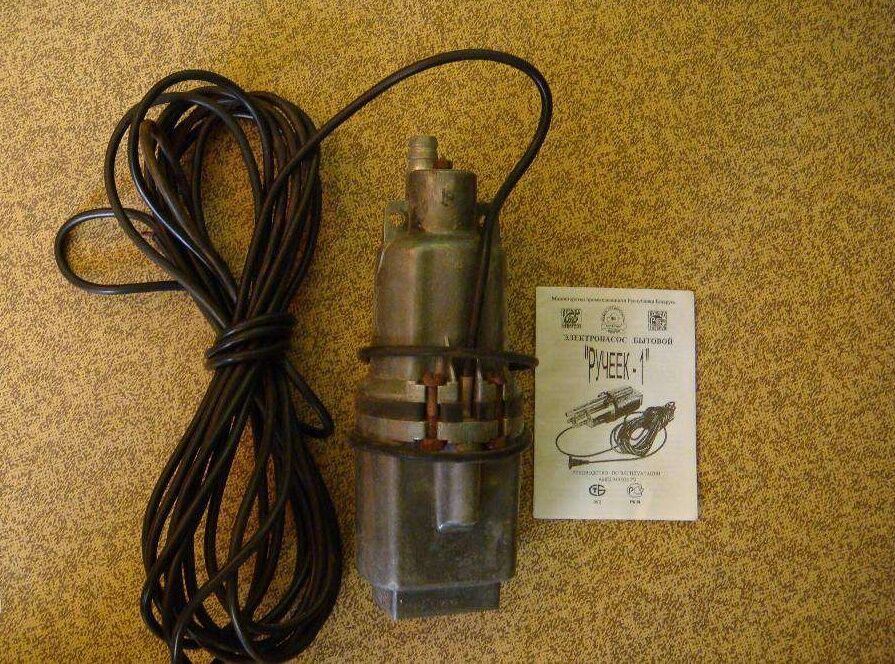
Each pump "Trickle" is completed with a technical passport. Before starting the installation of the device, the manufacturer's recommendations should be carefully studied and applied.
The cord must be strong enough to support up to five times the weight of the suspended equipment. In the case of “Rucheyk”, we are talking about twenty kilograms. Do not neglect this moment, because a pump that has fallen into a well can be a real disaster. And getting out of the broken equipment from the well is not the greatest pleasure.
It is not recommended to suspend vibration equipment on a metal cable, since such structures are poorly combined with the vibration effect that occurs during the operation of the unit. In order to partially dampen the vibration, the pump is attached to a cord on a suspension made of strong and elastic rubber, a piece of which must also be stocked up in advance.
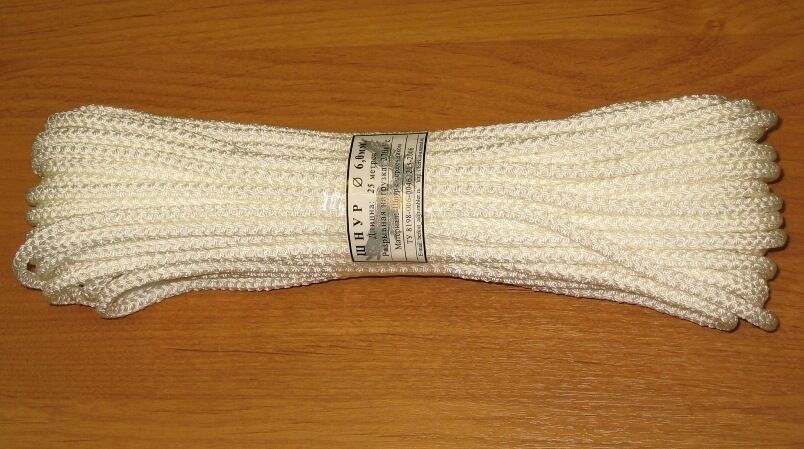
To suspend the Trickle pump, use a strong nylon cord that can withstand five times the load. If the length of the supplied cord is not enough, you need to purchase a new one; extension of the cord is unacceptable
Another necessary element is a hose through which water will flow upward. Its length must correspond to the immersion depth of the pump, and the diameter of the hose must fit the pump nozzle. However, there are adapters that allow you to attach a hose of a larger or smaller diameter to the branch pipe. The end of the hose on the branch pipe or on the adapter should be secured with a clamp, if other fastening methods are not provided.
If the use of a hose is undesirable or inconvenient for some reason, you can use a flexible plastic water pipe. It also needs to be securely fastened to the branch pipe with a clamp. If all the materials are prepared and the nuances are taken into account, you can proceed with the installation of the pump. To do this, you need to follow a series of simple steps:
- Unpack the Trickle pump, straighten the electric cable.
- Attach a nylon cord with a rubber adapter to the eyelet on its body.
- Attach a hose or water supply pipe to the pump outlet.
- Put on a special protective filter over the water intake hole.
- Gently and smoothly lower the pump into a well or borehole.
- Fasten the nylon cord.
- Connect the pump to the power supply.
- Press the power button and check the operation of the device.
When buying a Trickle pump, you should immediately clarify the length of the electrical cable that comes with the product. The standard model can be equipped with a cable length of 10, 15, 25 or 40 m, this is reflected in the cost of the device. If the wire is not long enough, the problem can be solved in one of two ways.
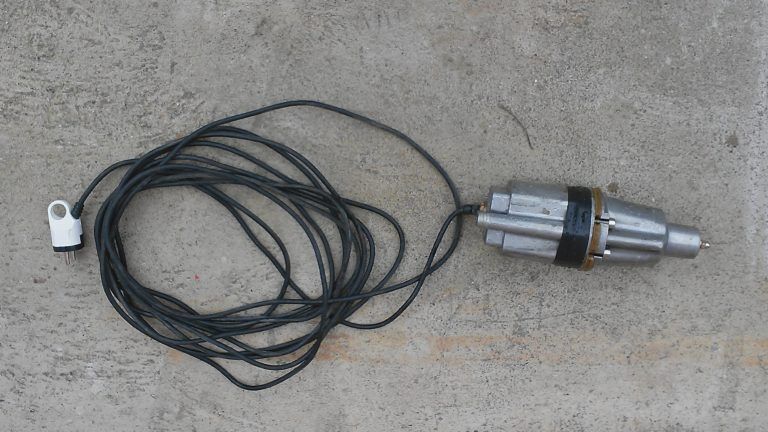
The cable length of the Trickle pump can be 10, 15, 25 or 40 meters. It is best to purchase the device right away with sufficient cable length.
The first is to completely replace the pump cable with a new wire of suitable length. To perform this operation, the pump will have to be disassembled and then reassembled. Sometimes it is easier to build up the cable, i.e. just attach a long enough piece to the existing wire.
The junction of the cables should be carefully insulated and protected with a special heat-shrink sleeve. Complete cable replacement is more reliable because the part of the cable submerged in water remains intact. But extension of the cable is less time consuming procedure. After the pump is lowered into the water, you should inspect the resulting system and make sure that the load falls on the nylon cord, and not on the cable or hose.
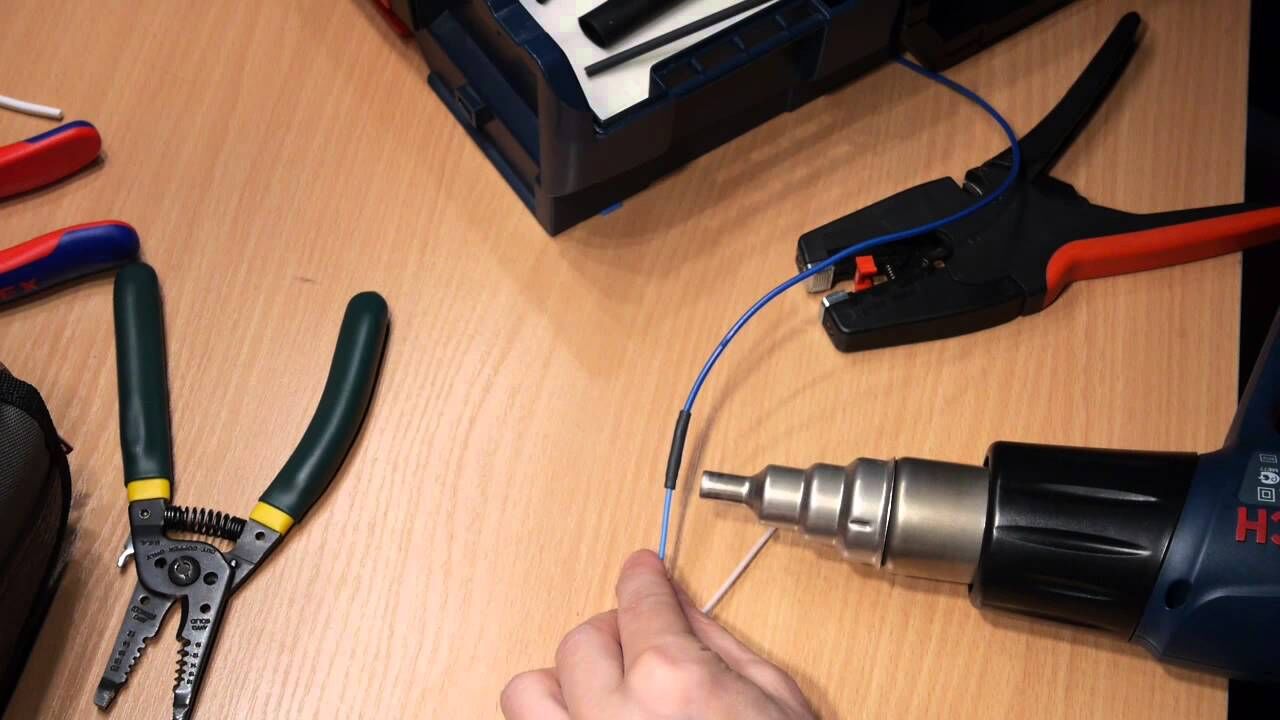
If it is decided to extend the electrical cable of the Trickle pump, a special heat-shrink sleeve should be used to protect the connection
Both the cable and the hose should hang freely without being taut. However, excessive sagging of the cable must not be allowed, since in the process of lowering and raising the pump, it can become entangled, and this will create additional problems. Correct use of the pump will increase its life and trouble-free operation. The manufacturer indicates the time of continuous operation of the pump no more than 12 hours.
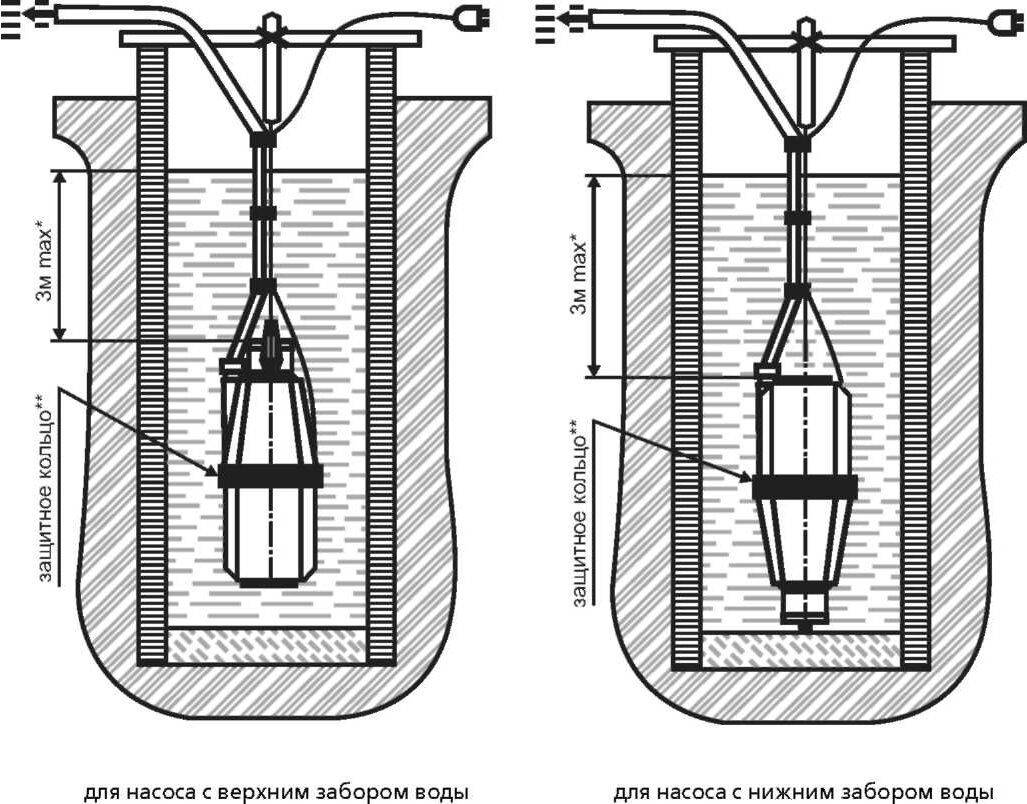
This diagram clearly shows the installation procedure for a "Trickle" type pump, depending on the model, which can be with a lower or upper water intake.
After that, the device should be turned off so that it cools down. Manufacturers also recommend taking short breaks every two hours of instrument operation. Such a gentle mode of operation will have a positive effect on the service life of the device. When hanging the device, remember that it should be located about 0.5-1 meters from the sandy bottom, otherwise it may simply be sucked into the sand or a layer of silt.
Advantages and disadvantages
The popularity of the trickle submersible pump can be easily explained: at a relatively low price, this device has a fairly high quality. But this is not its only advantage. The Trickle is extremely easy to use. It needs to be specially configured in some way, just press the power button and it will start working.
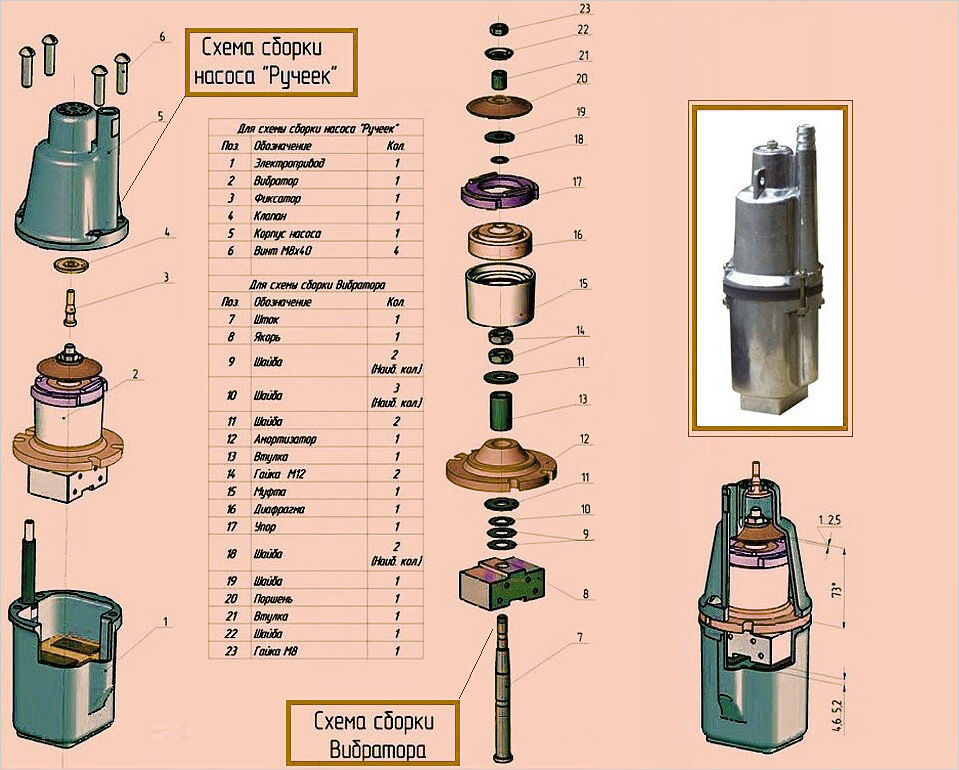
This diagram shows the constituent components of the Trickle pump. In the event of a breakdown, the device is not difficult to disassemble and repair
The simple design of the pump makes it extremely maintainable. In the event of a breakdown, the pump is not difficult to disassemble, repair or replace the damaged components, and then reassemble. All the components necessary for the repair are usually available commercially. The next “plus” of this pump is a wide range of tasks that can be solved with its help.
"Stream" pump not only clean water, but also some contaminated liquids, although this shortens its service life. The disadvantages of the "Trickle" pump include the nature of its work. Continuous vibration exposure can adversely affect the condition of the filter well. Vibrations destroy the sand layer, which increases the speed of sanding the well and can completely disable the structure.
A deep well that extracts water from fractured limestone is not afraid of vibration, but the "Stream" is not designed to digest water from such a great depth. Therefore, this type of pump is not suitable for continuous operation in sand wells. However, for taking water from a well, such equipment can be a real godsend.
"Stream" for all occasions
A relatively shallow well with a low flow rate or a well with similar characteristics is best equipped with a Trickle pump or other budget model. More powerful and expensive equipment is simply not needed here. It will empty the well too quickly, the risk of dry running in such a situation is very high.
The data sheet of the product says that the pump is intended only for the digestion of clean water. However, over the decades of the model's existence, the owners of private houses and summer cottages have found a wide variety of applications for this device. For example, this model is widely used when pumping filter wells.
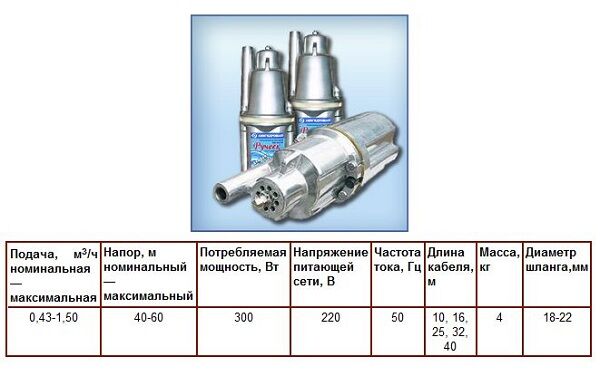
This table shows the main characteristics of the Trickle pump, thanks to which this unit is able to cope with the solution of many economic problems
At the end of the drilling of such structures, the water remains heavily contaminated with particles of silt, sand, etc. To obtain potable clean water, this mixture must be performed. Practice has shown that "Trickle" copes well with this task. A feature of the trickle pump device is that there are no rotating parts in it. Therefore, it does not clog up too quickly when working in polluted water.
Periodically, the pump is removed, disassembled, washed, the necessary repairs are carried out, and then reassembled and put into operation. Of course, with this treatment, the wear rate increases significantly. It is not surprising that in the process of pumping a well, the pump can completely fail.
To clean one well, depending on the situation, you may need two or even three or four such units. But in terms of money, it comes out much cheaper than purchasing special equipment with increased wear resistance. Inexperienced site owners sometimes believe that it is possible to pump a well with the help of the pump that will supply water to the water supply system of the house. This is an absolutely wrong decision.
The owners of wells and wells periodically have to clean their structures. In these cases, this type of pump is irreplaceable. It will effectively cope with pumping contaminated water from a well or borehole. If the pump is at hand, all work will be completed much faster. If the well is silted up or covered with sand, the vibrations that occur during the operation of the "Brook" turn from an enemy into a friend.

This is the disassembled pump "Trickle". Robust steel case reliably protects the device from external influences and frequent breakdowns
High-quality and expensive submersible pumps are usually designed for long-term operation with clean water. It is better to pump water that is abundantly polluted with sand with the help of “Brook” or other budget equipment. If, after pumping the well, some “Rucheyk” managed to “survive”, it will certainly find further application.
The vibrating action allows you to quickly and effectively destroy the mud plug, unclog the holes of the well screen and pump out the dirt to the surface. As a result, the well production rate will increase significantly. For cleaning silted wells, it is recommended to use a model with an upper water intake.
Image gallery

Flooding of a basement, inspection pit in a garage or other similar depression with drainage water is an unpleasant situation. And it will take a lot of time and effort to scoop out unnecessary liquid with a bucket. Since drainage water usually contains not so much contamination, the Trickle pump is ideal for pumping it out.
It works slowly, of course, but it is stable. Of course, one cannot expect ideal purity from drainage waters. To improve the performance of the pump, it is recommended to use a special additional filter that protects the structure from contamination. The filter is in the form of a cap and is intended for the top of the pump. To put it on, it is recommended to first warm up this element. Then the installation of the filter will be much faster and easier.
If the house has a pool or other capacious water reservoir, the Trickle pump can be used to pump water out of such containers. In this case, it makes sense to use the Trickle-1M model. Unlike other models, it is equipped with a bottom water intake, which allows you to completely remove water from the tank.
Pumps of the "Trickle" type are also used when installing heating systems, namely, for pressure testing, when the system needs to be filled with water. Water can be taken from the well or brought in a separate barrel. A hose is put on the pump inlet and lowered into the water. The second hose, put on the pump supply pipe, is connected to the open drain valve of the heating system.
A pressure gauge is used to monitor the pressure in the system. After pressure testing, the identified faults are eliminated. In general, we can say that pumps of the "Trickle" type can be used to solve almost any problem of pumping liquid or pumping it to its destination. The main requirement is that the water should not be too dirty.
Models and analogues
Three models of such a pump can be found on the market: "Trickle" (manufactured by JSC "Livgidromash", Russia), "Trickle-1" and "" Trickle-1M "(manufactured by JSC" Technopribor ", Belarus). They are very similar in design, but there are some differences. So, the model "Trickle-1" is equipped with an upper water intake system, which allows you to get the purest drinking water.
But at “Rucheyka-1M” the hole for water intake is located at the bottom. With this model, it is more convenient to pump out water from tanks that need to be emptied completely. Since in the Trickle and Trickle-1 models, water is taken from the top, the design itself serves as a reliable protection against overheating.
The water entering the pump housing simultaneously cools the motor. During testing, it was confirmed that this type of device can withstand dry running for seven hours. In this case, the windings of the electric motor do not burn out. Not all pumps, even more expensive and efficient ones, can boast of this level of stability. With a long time of operation of the pump without water, in many other models the electric motor simply burns out.
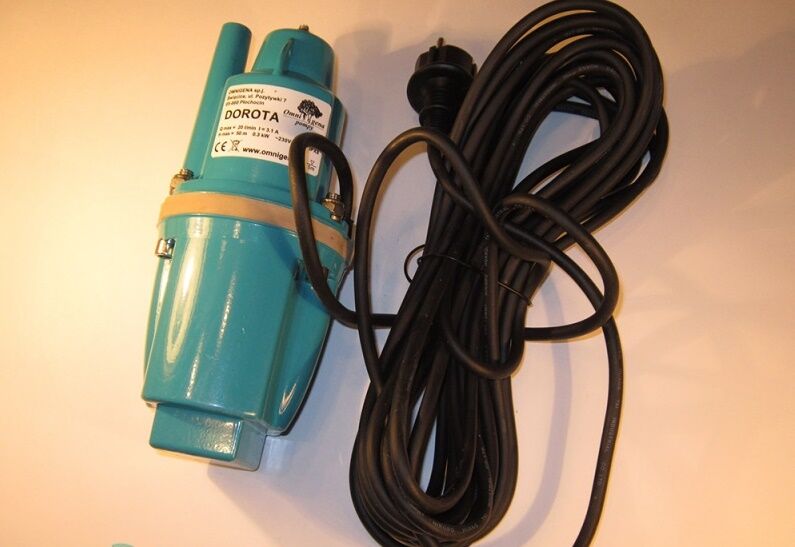
The Omnigena-Dorota pump is a worthy analogue of the Rucheyka, developed and manufactured in Poland. Differs in high quality and good performance
Among the pumping equipment similar to the "Rucheyk" one cannot but recall the "Malysh" pump. It is very close to Rucheyk in terms of technical characteristics, quality of performance, and maintainability. This equipment is produced by the Bavlenskiy plant “Electrodvigatel”, as well as AEK “Dynamo” (Moscow). Some indicators of "Malysh" are slightly better, but the price is also slightly higher than that of "Rucheyk".
Among the less well-known analogues, it is worth mentioning UNIPUMP BAVLENETS - a Russian brand that is produced in China. A study of the technical characteristics of the unit shows that it is not much different from the more famous “Brook”. The price characteristics of these pumps are also practically the same. The price for the same pump may vary depending on the cable length.
Omnigena-Dorota, a Polish-made submersible vibration pump, can be an interesting alternative. The principle of its operation and the device is not much different from the pump "Trickle". Unless the aluminum body is slightly shorter and the pump weighs a little less. The power of the model is 300 W, and it can be immersed at 50 m. Reviews about the quality of the Polish pump are quite satisfactory.
Interesting video about the pumps "Trickle"
Visual information on using the Trickle pump is contained in the following video:
Here you can see a practical example of the pump of this brand:
The Trickle pump is a tireless worker and a faithful assistant for all owners of summer cottages and private plots. Of course, its performance is not very great, and it is not designed to solve global cleaning tasks. But where it is necessary to pump water or clean out a well, "Trickle" may be the best option.



